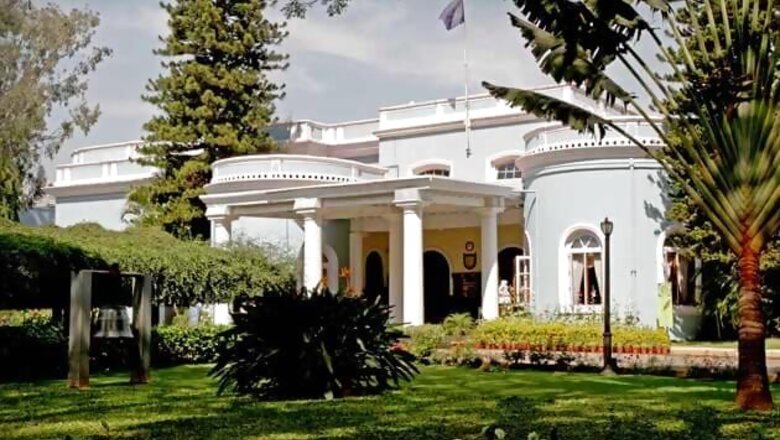
views
New Delhi: Former Prime Minister HD Deve Gowda, DMK chief M Karunanidhi and Samajwadi Party chief Mulayam Singh Yadav can't enter most of the clubs across India. The reason is what they wear is not an appropriate dress for the most of the elite clubs in the country. Fortunately, these leaders are not known for spending their free time at the clubs. No loss for them!
The recent incident of not allowing a Madras High Court judge into Tamil Nadu Cricket Association Club in Chennai has triggered a controversy. It has led to a nationwide debate on the relevance of dress code which is being strictly followed by most of the clubs in India.
The Madras High Court judge Justice D Hariparanthaman was denied entry into the Tamil Nadu Cricket Association Club recently for wearing dhoti. When he alighted from his official car at the club premises to participate in a book release function organised by TS Arunachalam, a former Chief Justice of the High Court, some staff of the club told him that he could not enter the premises wearing dhoti as they had instructions from the office-bearers not to allow anyone in the premises who violated the club's dress code. The judge has termed the incident as "unfortunate". Gnanadesikan said it was "regrettable" that a High Court Judge was denied entry for wearing dhoti.
Almost all Tamil political parties are opposing the archaic dress code which is a legacy of the British. They want these clubs to end such practices.
The debate over dress code is not new in India. Such incidents keep happening across India. Most of them go unnoticed. Only when the person involved or concerned is big, it gets media attention and usual protests erupt in the media. But, no club in India has changed its dress code because of the public pressure or media campaign. They maintain that the clubs are private institutions and not the public bodies to listen to the government. The people those who oppose the 'exclusivist' nature of the clubs argue that these clubs own huge public land and avail many other facilities from the government and they can't claim that they are private institutions.
Others argue that the dress code introduced by the British is now outdated and the British no longer control any of these clubs. They demand that the clubs must say goodbye to these meaningless British culture and adapt to the Indian culture. However most of the clubs are not ready to change the rules.
In 2002, the prestigious National Law School of India University (NLSIU), Bangalore Director Professor G Mohan Gopal was denied entry into the elite Bangalore Club founded in 1865. Because, he was dressed in dhoti and slippers. It led to a huge furore and the then chief minister of Karnataka SM Krishna, who is also an old member of the club, had stated that anything decent is acceptable and the dhoti clad guests should not be turned away.
A similar incident which happened at the same club last year proved that the past incidents had no impact on the club culture. Ashoke Chatterjee, former director of the National Institute of Design and a nephew of film maker Satyajit Ray, was denied entry into the Bangalore Club because he was not appropriately dressed. He belongs to a family that has been associated with the Bangalore Club for over 100 years. According to a newspaper report, modernity of society is a family concern, but what is being done in the name of 'modernity' at Bangalore club is a letdown for Chatterjee. Upset by the dress code at Bangalore Club that curbs men wearing traditional Indian attire, which he calls 'absurd,' Chatterjee decided to give up his life membership as a 'new year resolution.'
"Though I have been using the club for years, from 2006 I was restricted from entering the club because I was in Indian clothes. They say it's not part of the club's decorum. Now, the club has the right to formulate rules, but I only want them to put it in writing why they think wearing only western clothes is decent?" questioned Chatterjee.
Last year, the issue had come up for discussion in the Karnataka assembly, after a House committee under MLA D Hemachandra Sagar submitted a report highlighting the 'western clothes only' dress code of Bangalore's elite clubs. There was even a suggestion that a law should be put in place to eliminate such "colonial'' practices.
MK Chidambaranath, President, Bangalore Club at that time had admitted that it was a colonial thought, when questioned about the dress code. "We have only been carrying forward what the British have left behind. We consciously don't make changes, be it to the architecture of this club or the culture. There are times when some members have a medical problem in wearing formal shoes and so on. That's when we consider and give temporary relief," he had said reports 'Bangalore Mirror'.
At the Bangalore Club, there are many members who have a grouse about the dress code including Girish Karnad. In fact, a few years ago during Deepavali, even Infosys founder N R Narayana Murthy was turned away by the club for entering in kurta pyjamas.
In an article 'Of Course, the Raj Is Long Gone, But Oh-So-Select Clubs Carry On' published in 'The New York Times' in 1998, eminent editor Sunanda K. Datta-Ray beautifully explains it in following words, "When I was put up for membership of the Calcutta Club, an applicant with his proposer or seconder (sometimes both) had to run the gauntlet of the committee members, each regally ensconced at a small table. Arriving early for the ritual, my proposer, an Old Etonian Englishman who had made Calcutta his home, took me to the bar upstairs where we bumped into local nobility, the Maharajah of Burdwan, resplendent in brocade smoking jacket, who was also a committee member. 'I can only see you downstairs', he said, hospitably offering me a drink."
The British started the racially mixed Calcutta Club to mollify Indians who could not cross the threshold of the august Bengal Club, which was undoubtedly the grandest in an empire on which the sun never set because, whispered the irreverent, God could not trust it in the dark. The novelist John Masters assures us that there is no truth in the rumor of three members dying of apoplexy when they read at breakfast one morning that India would soon be independent. But the American colonel, a World War II honorary member, who peeped into the smoking room after lunch, might well have exclaimed, "Gee, back home we send them to the mortuary!"
The Bengal Club was not just white; it interpreted "all gentlemen received in general society," the definition of members, to mean only superior sahibs like the viceroy, his councilors, governors, the army top brass, and high court judges. Lesser sahibs, especially those in trade, had to be content with the Saturday Club, which, too, is still going strong but with Indian members. So is the Bangalore Club, which proudly displays the bill for a few rupees that Winston Churchill never paid, and the Ootacamund Club, where a young subaltern invented snooker while pottering with the cue and balls one lazy afternoon in 1875."
"A bright young spark is sometimes asked to leave sprawling Gymkhana Club in New Delhi or the pillared Adyar Club in Madras for flouting the dress code. Politicians then denounce colonial starch. Clubland fears a siege. But the storm blows over. People would feel bereft if these relics of the past were swept away, leaving them with no yardstick of social acceptance and no totems to protest against".
The refusal to change has a strong reason. Most of the elite clubs in India have retired bureaucrats, police officers, military officers and corporate leaders as their members. They control the club administration and don't want to change the rules which may threaten their cosy club. They want to keep the British legacy alive by strictly following the dress code and the club culture, which actually helps them to keep the club doors shut on dhoti clad, pyjama clad and slipper wearing people, whom they don't consider gentlemen enough to share the club dining hall with them.



















Comments
0 comment